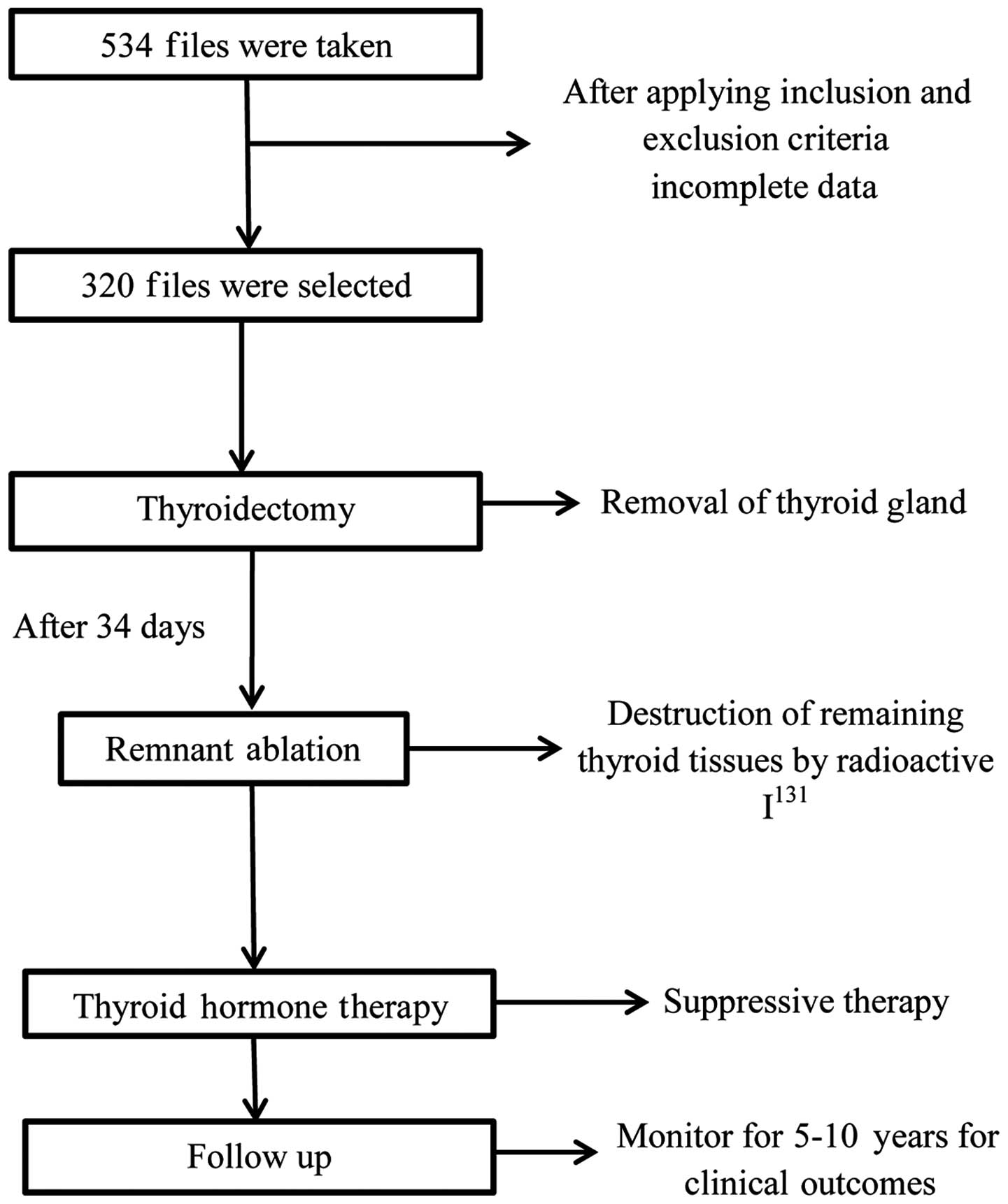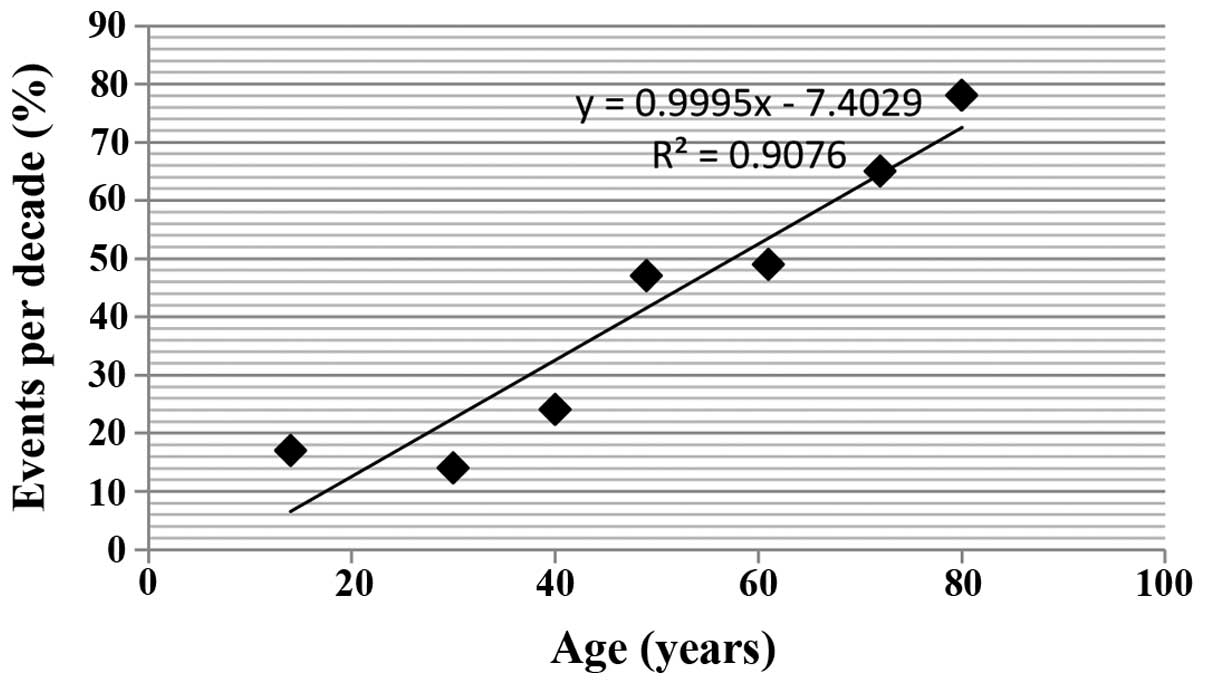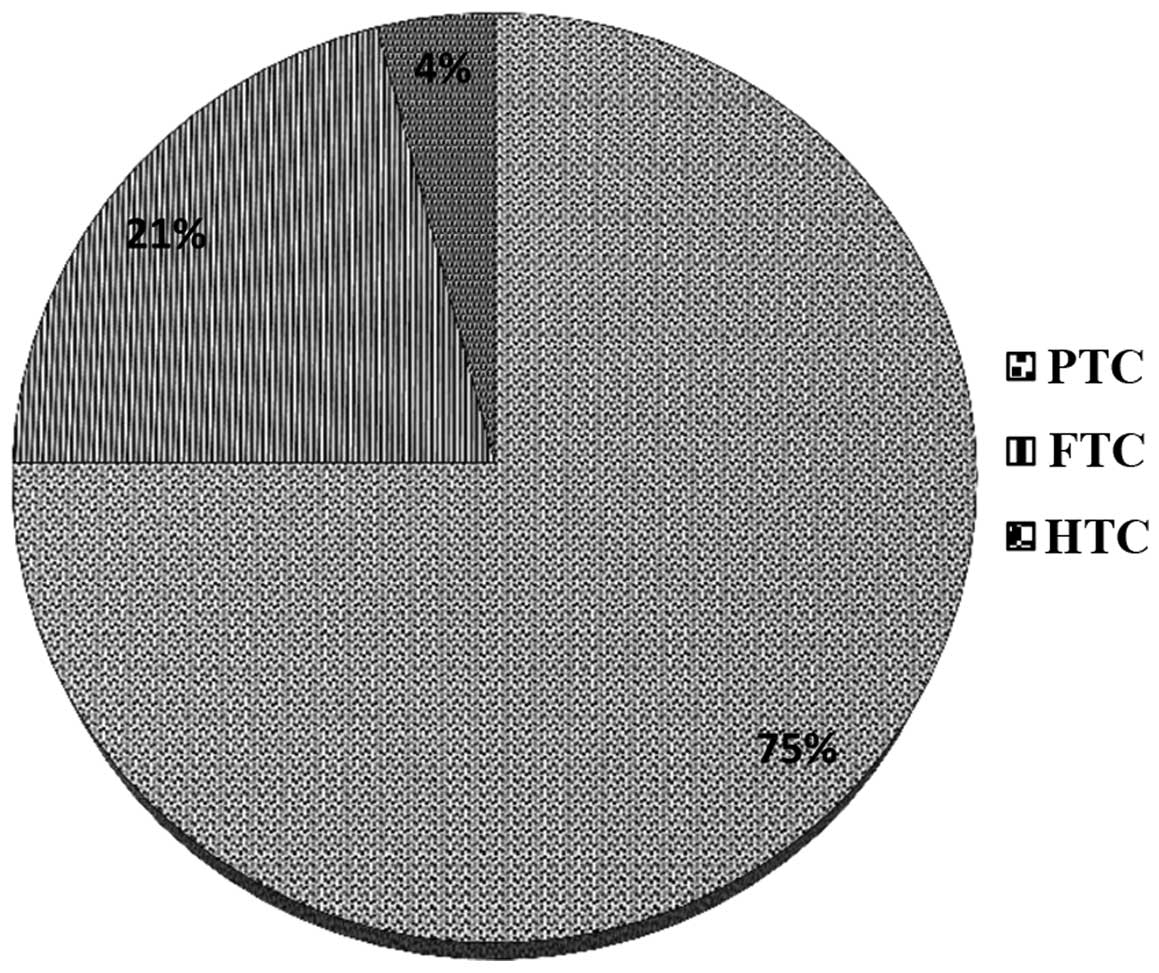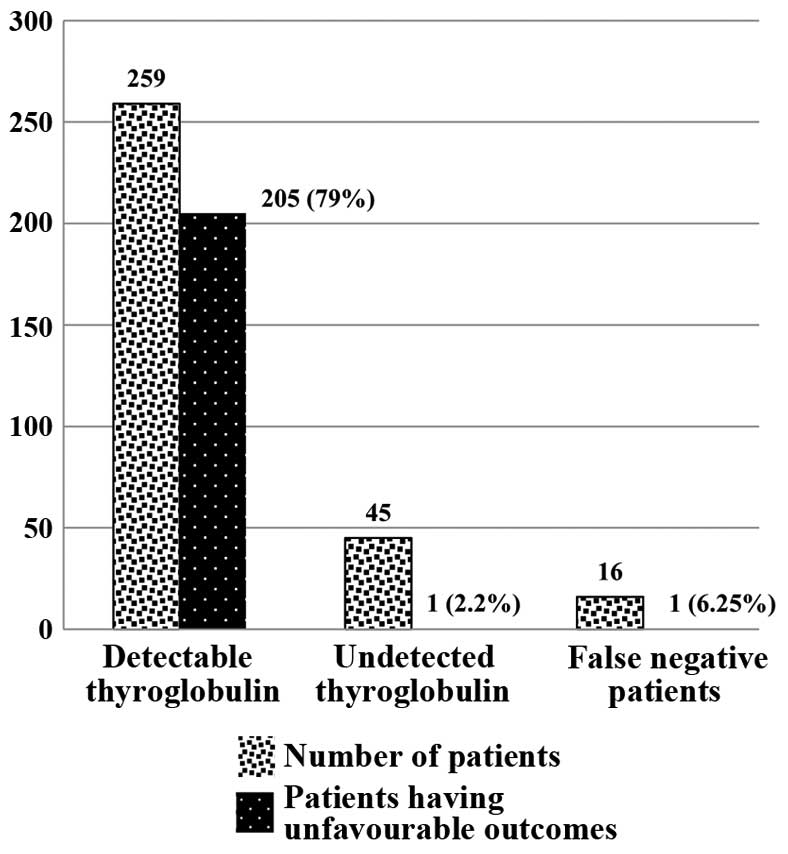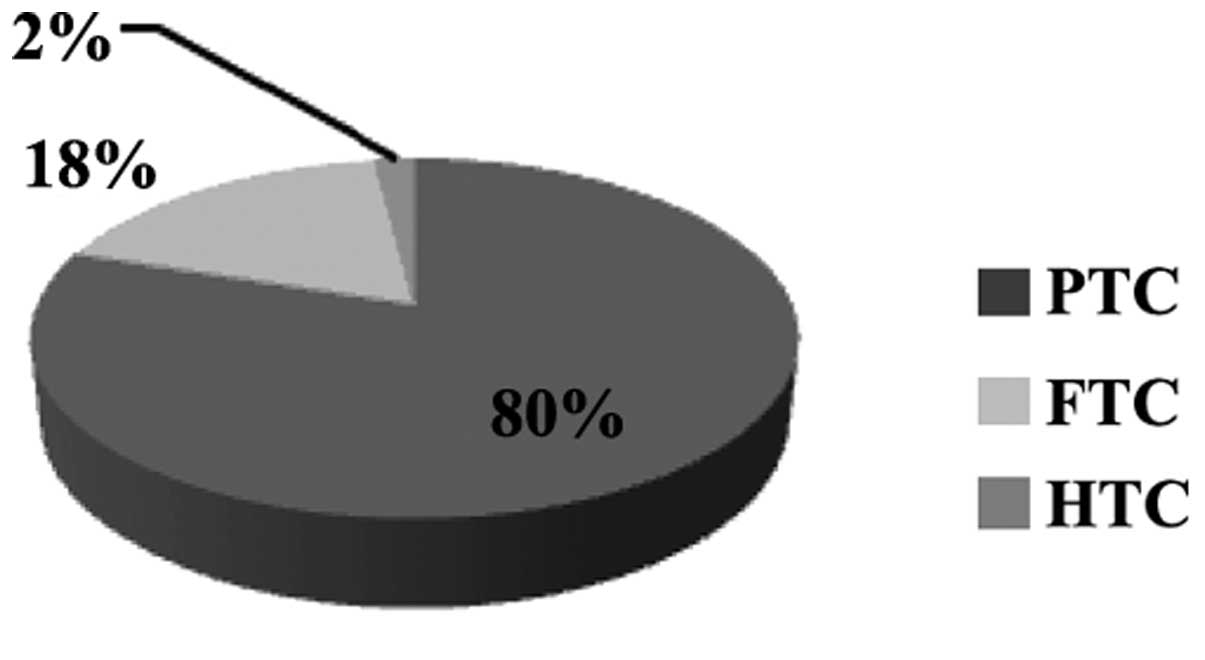Association between prognostic factors and clinical outcome of well-differentiated thyroid carcinoma: A retrospective 10-year follow-up study
- Authors:
- Published online on: June 24, 2015 https://doi.org/10.3892/ol.2015.3416
- Pages: 1749-1754
Abstract
Introduction
Differentiated thyroid carcinoma (DTC) is among the most common metabolic disorders, and accounts for 98% of all cases of thyroid cancer. Annually, 20,000 new cases of DTC are diagnosed in USA, and 200,000 patients undergo monitoring for recurrence or progression of the disease (1,2). There are three main types of thyroid carcinoma: Well-differentiated thyroid carcinoma (WDTC), poorly differentiated thyroid carcinoma (PDTC) and undifferentiated thyroid carcinoma (UDTC). WDTC has a better prognosis and decreased mortality and morbidity rates compared with PDTC and UDTC. WDTC neoplasms may arise from follicular cells [papillary (PTC), follicular (FTC) or Hürthle cell (HTC)carcinomas] or from parafollicular cells (medullary thyroid carcinoma) (3,4). Although WDTC accounts for <1% of all cancers, it results in >70% of mortalities from thyroid carcinomas (5).
A number of studies have attempted to determine the prognostic factors associated with WDTC. However, these studies yielded conflicting results (6–8), which may be due variations in the study settings and in the participants enrolled in each study. Furthermore, the use of different pathological classifications of WDTC and of different treatment approaches may have contributed to the heterogeneity among the studies. In order to overcome these limitations, the present study used a sample of WDTC patients undergoing the same treatment, to test the prognostic significance of clinical and pathological factors of WDTC. The identification of clinicopathological factors in cancer is crucial to improve the accuracy of recurrence rate estimates, and to facilitate the calculation of patient-specific disease mortality rates. Furthermore, it aids in the selection of therapeutic modalities and in determining the frequency of follow-up examinations (9).
Materials and methods
Subjects
The current study utilized a retrospective study design to collect medical documentation of patients suffering from WDTC, who were treated at the same institute with a minimum follow-up period of 10 years. A single center was used for data collection to avoid variation in treatment modalities and facilitation of follow-up. A number of classification systems may be used to classify WDTC: De Groot (stage 1, intrathyroidal; stage 2, cervical node metastases; stage 3, extrathyroidal system; stage 4, distant metastases) (10); AMES (age, metastases, extra thyroidal invasion, size of tumor) (11); or TNM (tumor size, nodal status, metastases) (12). For the current study, the De Groot classification system was selected, as it utilizes the combination of clinical, surgical and pathological data (13,14).
Inclusion criteria
Patients with a complete medical record of ≥10 years with the selected treatment regimen were included. The study was approved by the ethical review board of Nanfang Hospital (Guangzhou, China; reference no. HG/2012/6776891).
Exclusion criteria
Patients with incomplete medical records, with a follow-up period of <10 years, or who succumbed to medical conditions other than thyroid carcinoma were excluded from the study.
Treatment
All patients were given I131 treatment 34 days following thyroidectomy. The dosage of I131 used varied depending on the clinical condition of the patients. Following whole body scan, the presence of serum thyroglobulin was considered a ‘positive result’, and an absence was considered a ‘negative result’. Thyroglobulin levels were measured using RIA kits (#KR6270; Kronus, Inc., Star, ID, USA) that were able to detect <1µg/l, while a radioimmunoassay was used to detect anti-thyroglobulin antibodies. Follow-up examinations were conducted every three months for the first two years, and biannually thereafter, and clinical factors were recorded for each patient. Unfavorable clinical factors included the presence or persistence of increased thyroglobulin levels, recurrence or mortality due to thyroid carcinoma. The following were considered to be favorable clinical outcomes, indicating effectiveness of the treatment regimen: Undetectable serum thyroglobulin, very low level of serum thyroglobulin or complete absence of thyroglobulin (negative result at follow-up scan). A brief overview of the methodology adopted for the current study is shown in Fig. 1.
All subjects underwent the following treatment: i) After performing radical surgery (i.e. thyroidectomy) all patients underwent a radioiodine scan and evaluation of serum thyroglobulin level; ii) all subjects with hypothyroidism were treated with radioactive iodine I131 thyroid ablation (dose, 25–30 mCi) 34 days after the first surgery; iii) subjects with traceable amounts of serum thyroglobulin without the presence of anti-thyroglobulin antibodies were treated with an increased dose of I131 (100–150 mCi) to achieve normal thyroglobulin levels; iv) all subjects were treated with thyroid stimulating hormone suppressive therapy.
Statistical analysis
Continuous data are presented as the mean ± standard deviation, while categorical data are presented by numbers or frequencies. All the data was analyzed using SPSS software, version 20.0 (IBM SPSS, Armonk, NY, USA). Univariate and multivariate analyses were conducted in stepwise manner to evaluate prognostic factors associated with WDTC. P<0.05 was considered to indicate a statistically significant difference.
Results
In total, 320 patients with WDTC were selected to participate in current study. The demographic profile of the subjects is summarized in Table I.
The mean age of the participants was calculated to be 45.3±17.9 years. The mean follow-up period was 87.9 months. Of the 320 patients, 253 (79%) had undergone a single thyroidectomy, while the remaining 67 (21%) had undergone a second surgery 14 days after the initial surgery (i.e. partial resection). The following pathological subtypes of WDTC were identified among the participants: 240 (75%) PTCs, 67 (21%) FTCs and 13 (4%) HTCs. At the end of follow-up, the following unfavorable outcomes were observed: 109 (34%) patients presented with persistent or recurrent carcinoma and 13 (4%) patients succumbed to carcinoma. Table II summarizes the prognostic factors along with their statistical significance as determined by multivariate analysis.
Table II.Prognostic factors associated with well-differentiated thyroid carcinoma at the end of the follow-up period. |
Gender
The rate of unfavorable clinical outcomes did not differ significantly between males and females; unfavorable clinical outcomes were observed in 62 (51%) females versus 60 (49%) males at the end of study (P=0.435).
Age
In the present study, 48 years was observed to be the age above which the majority (66%; 81 individuals) of the unfavorable outcome population were. By contrast, only 73 (37%) disease-free subjects were above this age (P<0.001). Additionally, the presence of distal metastases during the follow-up period was more common among the subjects >48 years of age, compared with the younger subjects (P<0.001). Young age (<20 years) was associated with better clinical outcome than the older age group (>48 years) (71.7% vs. 28.3%; P<0.001, respectively). The association between age and unfavorable clinical outcomes is shown in Fig. 2.
Pathological subtype of carcinoma
Histological examination at the time of diagnosis, revealed that PTC was observed in the greatest number of subjects (240 cases; 75%), followed by FTC (67 cases; 21%) and HTC (13 cases; 4%) (Fig. 3). During diagnosis and follow-up, PTC was associated with the highest rate of lymph node involvement (P=0.002 vs. 0.004) compared with FTC and HTC. In subjects with unfavorable clinical outcomes, HTC was observed in the highest number of subjects (69 cases; 57%) and was associated with poorer clinical outcomes (P=0.005) on univariate analysis. However, multivariate analysis demonstrated no significant difference (P=0.325).
Tumor size
Examination of tumor size revealed that FTCs had the greatest diameter (mean ± SD, 44.7±16.8 mm] followed by HTC (mean ± SD, 29.8±9.8 mm). The mean diameter of PTC was the smallest (mean ± SD, 26.3±15 mm). The size of the tumor was strongly correlated with clinical outcome (Fig. 4); regardless of tumor type, a tumor size of >50 mm was significantly associated (P=0.03) with unfavorable clinical outcomes, including recurrence of disease or mortality.
Involvement of nodes
The involvement of nodes, at the time of surgery or follow-up examination, was not significantly associated with clinical outcomes. At the time of surgery, 121 (38%) subjects had involvement of nodes; 47 (39%) of these subjects showed unfavorable clinical outcome at end of the follow-up period (P=0.126). During follow-up, 80 patients (25%) exhibited nodal involvement, and 12 (15%) had unfavorable outcomes (P=0.354; Fig. 5).
Thyroglobulin
At 6 months following thyroid surgery, 259 (80%) subjects had detectable serum thyroglobulin levels, while 45 (14%) had no detectable serum thyroglobulin; 16 (6%) had positive thyroglobulin antibodies with no detectable serum thyroglobulin (false negative patients). At the end of the 10-year follow-up period, unfavorable outcomes were observed in 205 (79%) patients with detectable thyroglobulin levels six months following thyroid ablation (P=0.001), while unfavorable outcomes were observed in only 1 (2.2%) patient without detectable serum thyroglobulin levels and 1 (6.25%) false negative patient (Fig. 6).
De Groot staging system
The De Groot classification system was used to categorize subjects into stages according to their level of risk. At the time of diagnosis, subjects were categorized as follows: Stage 1, 166 (52%); stage 2, 77 (24%); stage 3, 61 (19.2%); and stage 4, 16 (5%; Table III). At the end of the follow-up period, the highest percentage of unfavorable clinical outcomes was observed in subjects categorized as stage 4 (12 cases; 77%) while the lowest was identified in stage 1 (16 cases; 31%). These results indicated that the De Groot classification system is significantly associated with clinical outcome (P=0.005).
Tumor extension
Extrathyroidal tumor extension was observed in 64 (20%) patients at the time of diagnosis. Table IV shows the prevalence of tumor extension with respect to type of WDTC. This was independent of patient age and tumor size (P=0.561 and P=0.328, respectively). At the end of follow-up, 25 (39%) patients with extra-thyroidal extension showed favorable clinical outcomes (i.e. disease-free status). The results clearly showed that extension of tumors to recurrent sites is not a statistically significant prognostic factor of WDTC (P=0.387).
Tumor focality
At the time of diagnosis, multiple tumor foci in one or both lobes of the thyroid, were present in 70 (22%) study subjects. The prevalence of multifocality in different pathological types of WDTC is shown in Fig. 7; no statistically significant association was observed (P=0.234).
At the end of follow-up, 43 (61%) of the 70 patients that had exhibited multifocality showed favorable clinical outcomes (P=0.425). The prevalence of multifocality associated risk factors among patients at the time of surgery was also assessed (Fig. 8), demonstrating that multifocality is significantly associated with the risk of node development during follow-up (P=0.003).
Discussion
Although WDTC is the most common type of thyroid carcinoma, it is the only type of this carcinoma with a low mortality rate (15–17) and increased survival rate; the current study found a rate of mortality of 4% for this condition. However, a number of studies have reported a mortality rate of ≤10% (5,18). This difference may be attributable to variability in the use of treatment approaches and classification systems between studies. Despite the low mortality rate observed in the current study, the rate of recurrence is high. Therefore, the rate of persistence or recurrence of WDTC may be a better indicator of the mortality rate associated with this disease. The main limitation associated with the current study is its retrospective nature, with participants recruited from a single centre. The current study can serve as a basis for future prospective studies. Future studies should be conducted prospectively with a large number of patients from different centres, to enable effective generalization.
A number of studies have observed that males have poorer clinical outcomes than females, however, the current study found no significant difference between genders with regard to clinical outcome or prognosis (6,18–20). At the beginning of the study, involvement of nodes was more common among males compared with females (0.045), however, this difference was not significant based on multivariate analysis. Patient age was observed to be significantly associated with outcome in WDTC. As age increases, particularly after 48 years, the likelihood of unfavorable outcome increases. Similarly, young age was associated with favorable prognosis, consistent with a number of other studies (16,18,21). Previous studies demonstrated that patients with HTC or FTC were more likely to show unfavorable clinical outcomes compared with those suffering from PTC (22–24). Consistently, the present study found that patients suffering from HTC or FTC upon diagnosis were more susceptible to bone metastases. However, multivariate analysis showed that tumor size, and not tumor type, is a predictor of unfavorable clinical outcomes (P=0.03). Other factors associated with prognosis were the presence of thyroglobulin and De Groot stage. Thyroglobulin is a well-established marker of WDTC, and may be used to detect persistence or recurrence of the disease. The present study observed the highest rate of unfavorable outcomes in patients who had detectable serum thyroglobulin six months following thyroid ablation. The De Groot staging system, which classifies thyroid carcinomas based on extent of disease, was also found to be associated with prognosis.
The present 10-year follow-up study, conducted among patients undergoing same treatment, confirmed previous findings that WDTC is associated with a high survival rate and a low mortality rate. Unfavorable clinical outcomes were significantly associated with advanced age, tumor size, presence of thyroglobulin and extent of disease as classified by De Groot staging system.
Acknowledgements
The present study was supported by the Guangdong Provincial Natural Scientific Fund (S2013010016565) and the Natural Science Foundation of Southern Medical University (PY2013N034).
References
|
Kebebew E and Clark OH: Differentiated thyroid cancer: “complete” rational approach. World J Surg. 24:942–951. 2000. View Article : Google Scholar : PubMed/NCBI | |
|
Ringel MD and Ladenson PW: Controversies in the follow-up and management of well-differentiated thyroid cancer. Endocr Relat Cancer. 11:97–116. 2004. View Article : Google Scholar : PubMed/NCBI | |
|
Caron NR and Clark OH: Well differentiated thyroid cancer. Scand J Surg. 93:261–271. 2004.PubMed/NCBI | |
|
Patel KN and Shaha AR: Poorly differentiated and anaplastic thyroid cancer. Cancer Control. 13:119–128. 2006.PubMed/NCBI | |
|
Cushing SL, Palm CE, Audet N, Eski S, Walfish PG and Freeman JL: Prognostic factors in well-differentiated thyroid carcinoma. Laryngoscope. 114:2110–2115. 2004. View Article : Google Scholar : PubMed/NCBI | |
|
Mazzaferri EL: An overview of the management of papillary and follicular thyroid carcinoma. Thyroid. 9:421–427. 1999. View Article : Google Scholar : PubMed/NCBI | |
|
Akslen LA and LiVolsi VA: Prognostic significance of histologic grading compared with subclassification of papillary thyroid carcinoma. Cancer. 88:1902–1908. 2000. View Article : Google Scholar : PubMed/NCBI | |
|
Sugg SL, Zheng L, Rosen IB, Freeman JL, Ezzat S and Asa SL: ret/PTC-1, -2 and -3 oncogene rearrangements in human thyroid carcinomas: implications for metastatic potential? J Clin Endocrinol Metab. 81:3360–3365. 1996. View Article : Google Scholar : PubMed/NCBI | |
|
Tuttle RM: Differentiated thyroid cancer: Clinicopathologic staging. http://www.uptodate.com/contents/differentiated-thyroid-cancer-clinicopathologic-stagingOctober 6th–2013 | |
|
DeGroot LJ, Kaplan EL, McCormick M and Straus FH: Natural history, treatment, and course of papillary thyroid carcinoma. J Clin Endocrinol Metab. 71:414–424. 1990. View Article : Google Scholar : PubMed/NCBI | |
|
Kebebew E and Clark OH: Differentiated thyroid cancer: “Complete” rational approach. World J Surg. 24:942–951. 2000. View Article : Google Scholar : PubMed/NCBI | |
|
Rami-Porta R, Crowley JJ and Goldstraw P: The revised TNM staging system for lung cancer. Ann Thorac Cardiovasc Surg. 15:4–9. 2009.PubMed/NCBI | |
|
Weetman AP: Expert Consult: ThyroiditisConn's Current Therapy 2012. Bope ET and Kellerman RD: Elsevier Saunders; Philadelphia, USA: 2012 | |
|
Elisei R, Molinaro E, Agate L, et al: Are the clinical and pathological features of differentiated thyroid carcinoma really changed over the last 35 years? Study on 4187 patients from a single Italian institution to answer this question. J Clin Endocrinol Metab. 95:1516–1527. 2010. View Article : Google Scholar : PubMed/NCBI | |
|
Tanaka K, Sonoo H, Saito W, Ohta Y, Shimo T, Sohda M, Yamamoto Y and Kurebayashi J: Analysis of clinical outcome of patients with poorly differentiated thyroid carcinoma. ISRN Endocrinol. 2011:3080292011. View Article : Google Scholar : PubMed/NCBI | |
|
Holler T, Theriault J, Payne RJ, Clark J, Eski S and Freeman JL: Prognostic factors in patients with multiple recurrences of well-differentiated thyroid carcinoma. J Oncol. 2009:6503402009. View Article : Google Scholar : PubMed/NCBI | |
|
Palme CE, Waseem Z, Raza SN, Eski S, Walfish P and Freeman JL: Management and outcome of recurrent well-differentiated thyroid carcinoma. Arch Otolaryngol Head Neck Surg. 130:819–824. 2004. View Article : Google Scholar : PubMed/NCBI | |
|
Fonseca E, Soares P, Rossi S and Sobrinho-Simões M: Prognostic factors in differentiated thyroid gland carcinoma. Pathologe. 18:275–285. 1997. View Article : Google Scholar : PubMed/NCBI | |
|
Akslen LA, Myking AO, Salvesen H and Varhaug JE: Prognostic importance of various clinicopathological features in papillary thyroid carcinoma. Eur J Cancer. 29A:44–51. 1992.PubMed/NCBI | |
|
Mazzaferri EL and Jhiang SM: Long-term impact of initial surgical and medical therapy on papillary and follicular thyroid cancer. Am J Med. 97:418–428. 1994. View Article : Google Scholar : PubMed/NCBI | |
|
Baloch ZW and LiVolsi VA: Prognostic factors in well-differentiated follicular-derived carcinoma and medullary thyroid carcinoma. Thyroid. 11:637–645. 2001. View Article : Google Scholar : PubMed/NCBI | |
|
Schlumberger M and Pacini F: Thyroid tumors. 2nd. Nucléon Editions; Paris, France: pp. 18–24. 2003 | |
|
Lin JD, Chao TC and Hsueh C: Clinical characteristics of poorly differentiated thyroid carcinomas compared with those of classical papillary thyroid carcinomas. Clin Endocrinol (Oxf). 66:224–228. 2007. View Article : Google Scholar : PubMed/NCBI | |
|
Nishida T, Katayama M, Tsujimoto M, Nakamura J and Matsuda H: Clinicopathological significance of poorly differentiated thyroid carcinoma. Am J Surg Pathol. 23:205–211. 1999. View Article : Google Scholar : PubMed/NCBI |



